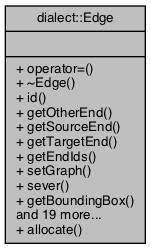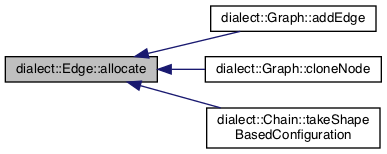The Edge class represents edges in a graph. More...
#include <graphs.h>

Public Member Functions | |
| Edge & | operator= (const dialect::Edge &)=default |
| Copy-assignment operator. | |
| ~Edge (void)=default | |
| Destructor. | |
| id_type | id (void) const |
| Access the unique ID of this instance. More... | |
| Node_SP | getOtherEnd (const dialect::Node &end1) const |
| Get the opposite endpt, from a given one. More... | |
| Node_SP | getSourceEnd (void) const |
| Get read-only access to the Node at the source end of this Edge. | |
| Node_SP | getTargetEnd (void) const |
| Get read-only access to the Node at the target end of this Edge. | |
| std::pair< id_type, id_type > | getEndIds (void) const |
| Get a pair {srcID, tgtID} giving the IDs of the source and target Nodes. | |
| void | setGraph (Graph &graph) |
| Tell the Edge which Graph it belongs to. More... | |
| void | sever (void) |
| "Sever" this Edge, i.e. remove it from the Nodes to which it is attached. | |
| BoundingBox | getBoundingBox (void) const |
| Get the bounding box for the edge, including its end points and route points. | |
| void | addRoutePoint (double x, double y) |
| Add a point to the route. | |
| void | setRoute (std::vector< Avoid::Point > route) |
| Set (overwriting) the entire route. | |
| std::vector< Avoid::Point > | getRoute (void) const |
| Get a copy of the Edge's route member. May be empty. More... | |
| std::vector< Avoid::Point > | getRoutePoints (void) const |
| Get route points. More... | |
| std::string | writeRouteTglf (void) const |
| Write TGLF to represent the route for this Edge. More... | |
| std::pair< Avoid::ConnEnd, Avoid::ConnEnd > | makeLibavoidConnEnds (Avoid::ConnDirFlags srcDirs=Avoid::ConnDirAll, Avoid::ConnDirFlags tgtDirs=Avoid::ConnDirAll) |
| Build and return a pair of libavoid ConnEnds to represent the endpoints of this Edge. | |
| void | setBendNodes (Nodes bends) |
| Set the bend nodes. These should be Nodes representing the bend points in the Edge's route. | |
| void | addBendNode (Node_SP bn) |
| Add a single bend node. | |
| Nodes | getBendNodes (void) |
| Access the Edge's bend nodes. | |
| bool | hasBendNodes (void) |
| Check whether this Edge has any bend nodes. | |
| void | rotate90cw (void) |
| Rotate the connector route 90 degrees clockwise. | |
| void | rotate90acw (void) |
| Rotate the connector route 90 degrees anticlockwise. | |
| void | rotate180 (void) |
| Rotate the connector route 180 degrees. | |
| void | translate (double dx, double dy) |
| Translate the connector route by a given amount in each dimension. More... | |
| void | clearRouteAndBends (void) |
| Clear the connector route and drop all bend nodes. | |
| void | buildRouteFromBends (void) |
| Build a connector route based on the bend nodes. | |
| std::string | writeSvg (void) const |
| Write SVG to represent this Edge. More... | |
| std::string | writePolylineConnectorData (void) const |
| Write the data for a polyline SVG path for this Edge's connector route. | |
| std::string | writeRoundedOrthoConnectorData (void) const |
| Write the data for an orthogonal SVG path for this Edge's connector route, using rounded bends. | |
Static Public Member Functions | |
| static Edge_SP | allocate (const Node_SP &src, const Node_SP &tgt) |
| Factory function. More... | |
Detailed Description
The Edge class represents edges in a graph.
Member Function Documentation
◆ allocate()
|
static |
Factory function.
We make all constructors private and offer a factory function instead, in order to ensure that instances are allocated on the heap, and always come with a shared ptr control block.
- Returns
- A shared_ptr to Node (Node_SP).
Referenced by dialect::Graph::addEdge(), dialect::Graph::cloneNode(), and dialect::Chain::takeShapeBasedConfiguration().

◆ getOtherEnd()
| Node_SP Edge::getOtherEnd | ( | const dialect::Node & | end1 | ) | const |
Get the opposite endpt, from a given one.
- Returns
- The Node_SP lying at the other end.
References dialect::Node::id().
Referenced by dialect::Node::removeEdge().


◆ getRoute()
|
inline |
Get a copy of the Edge's route member. May be empty.
- Note
- If you are interested in drawing a connector, see the getRoutePoints method.
- See also
- getRoutePoints
◆ getRoutePoints()
| vector< Point > Edge::getRoutePoints | ( | void | ) | const |
Get route points.
- Note
- This method returns the points that form the route you would draw for this edge. If the m_route vector is nonempty, a copy is returned. Otherwise you get a vector of two points: the centre of the source Node, and the centre of the target Node.
- See also
- getRoute
Referenced by writePolylineConnectorData(), writeRoundedOrthoConnectorData(), and writeSvg().

◆ id()
|
inline |
Access the unique ID of this instance.
- Returns
- The ID.
Referenced by dialect::Node::removeEdge(), and dialect::Graph::severEdge().

◆ setGraph()
|
inline |
◆ translate()
| void Edge::translate | ( | double | dx, |
| double | dy | ||
| ) |
Translate the connector route by a given amount in each dimension.
- Parameters
-
[in] dx The amount by which to translate in the x-dimension. [in] dy The amount by which to translate in the y-dimension.
◆ writeRouteTglf()
| string Edge::writeRouteTglf | ( | void | ) | const |
Write TGLF to represent the route for this Edge.
- Returns
- A string containing the TGLF.
◆ writeSvg()
| string Edge::writeSvg | ( | void | ) | const |
Write SVG to represent this Edge.
- Returns
- A string containing the SVG.
References getRoutePoints(), writePolylineConnectorData(), and writeRoundedOrthoConnectorData().

The documentation for this class was generated from the following files:
- libdialect/graphs.h
- libdialect/edges.cpp
- libdialect/graphs.cpp
 1.8.14
1.8.14